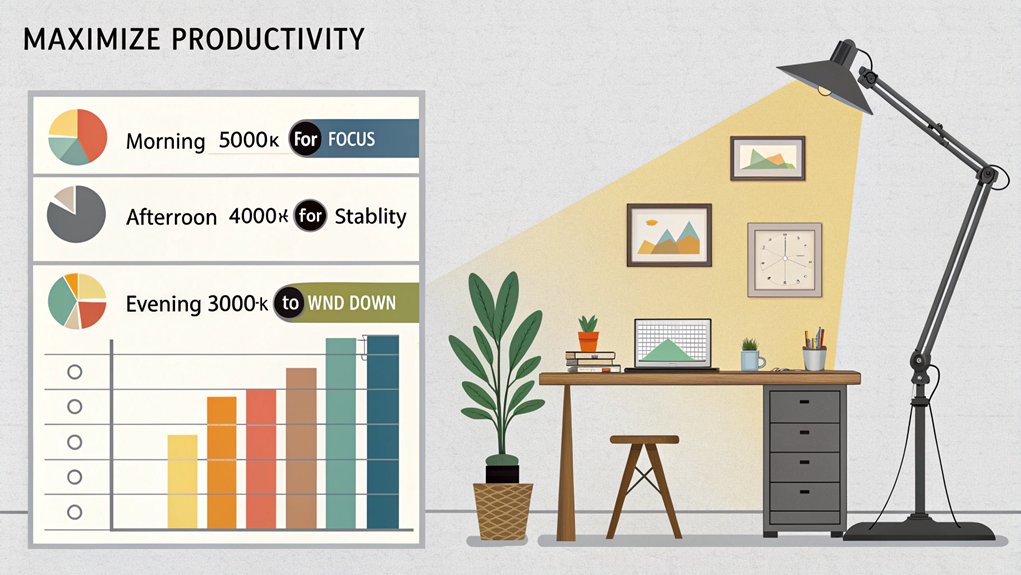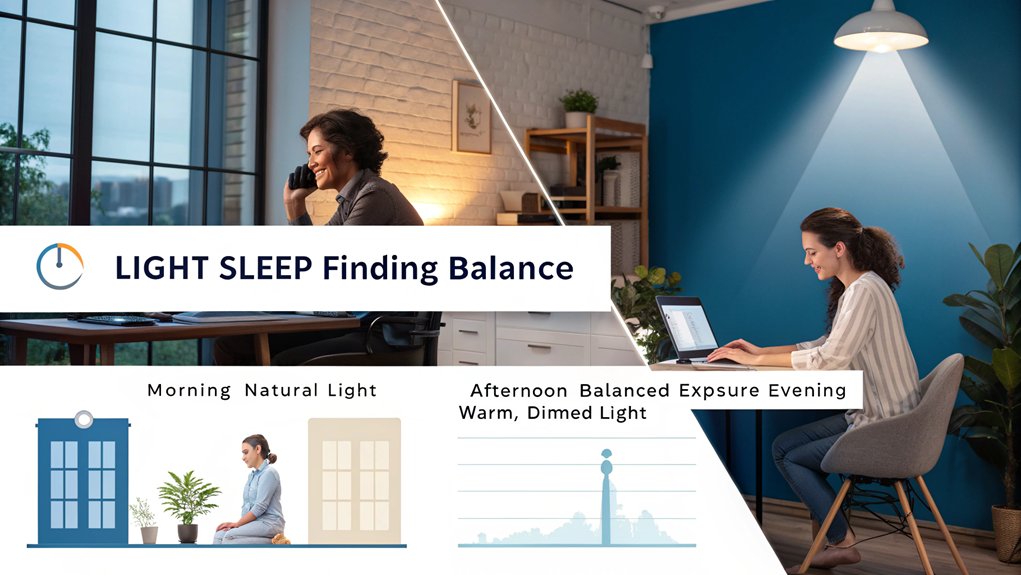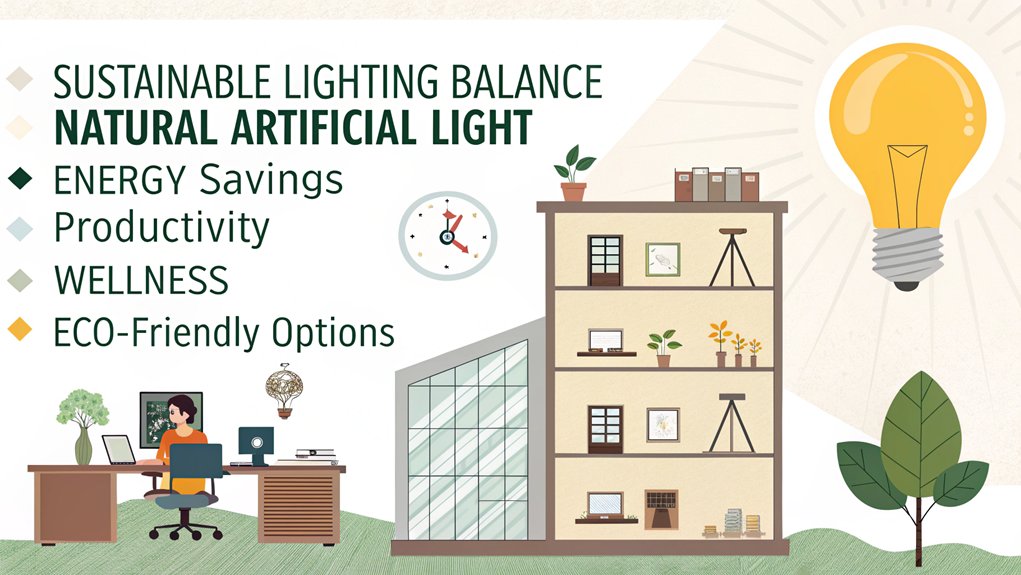Imagine a workspace where light dances gently through the window, enhancing your creativity while keeping the shadows at bay. In the quest for a perfect home office, finding the right balance of natural vs artificial lighting can make all the difference. Both forms of illumination hold unique benefits that can either uplift or hinder your productivity. So, how do you weave them together seamlessly for a harmonious work environment? Let’s explore the key components that can transform your space.
Key Takeaways
- Maximize natural light by positioning your workspace near windows and using reflective surfaces to enhance brightness and mood.
- Incorporate task and ambient lighting to create a balanced environment for productivity and comfort in your home office.
- Utilize LED bulbs that mimic daylight to reduce eye strain while being energy-efficient, especially in areas lacking natural light.
- Limit artificial light exposure in the evening to maintain healthy circadian rhythms and encourage better sleep quality.
- Harmonize natural and artificial lighting to create a vibrant workspace that enhances focus, creativity, and overall well-being.
The Health Benefits of Natural Light in Your Workspace
When you let natural light flood your workspace, you’re not just brightening up the room; you’re also nurturing your well-being. Embracing these natural light benefits does wonders for your mood, releasing serotonin that elevates happiness. Imagine, too, how it cultivates workplace satisfaction—employees who bask in sunlight report lower absenteeism and heightened engagement. Your circadian rhythm gets a boost, leading to restful nights that enhance daily alertness. The gentle warmth of daylight reduces eye strain, letting you focus on your innovations without discomfort. Access to natural light significantly boosts health and wellness among workers, ensuring you remain inspired and productive throughout your day. Every ray of sunlight increases energy levels, transforming fatigue into inspiration. Incorporating natural light into your design can create a vibrant atmosphere that enhances overall productivity in your workspace.
Maximizing Productivity With Artificial Lighting

Productivity thrives on the right ambiance, and artificial lighting plays a critical role in creating it. To spark your creativity and focus, invest in task lighting that directs brilliance where you need it most, like desk lamps with adjustable arms. Incorporating adequate lighting into your workspace design not only enhances visual appeal but also fosters efficiency and concentration. Proper artificial lighting prevents eye strain and improves productivity, making it an essential component of your home office setup.
Embrace the invigorating glow of LED bulbs with color temperatures between 3500K and 5000K, which mimic daylight and keep your mind alert. Balance this with ambient brightness, enveloping your space in a comforting glow that nurtures a serene environment.
Layering different lighting types allows you to adapt the mood and functionality effortlessly. Smart lighting systems can automatically shift in harmony with your work rhythm, ensuring you’re always in the zone, maximizing your productivity while enhancing your workspace’s aesthetic appeal.
Understanding Light Quality: Natural vs. Artificial Lighting

As you immerse yourself in the world of home offices, understanding the nuances of light quality can greatly impact your workspace and well-being.
Natural light offers a dynamic light spectrum that shifts throughout the day, enhancing your mood and energy levels as it fills your room. Additionally, natural light can help regulate hormones based on its color composition, further promoting well-being. This is particularly important because exposure to natural light has been shown to synchronize circadian rhythms, which play a crucial role in our overall health.
In contrast, artificial light, while energy-efficient and controllable, often presents a fixed color temperature that can distort the true colors around you. It lacks the variety and biological benefits of sunlight, limiting visual clarity and overall health.
By harmonizing both light sources, you can create an inviting environment. Aim for artificial lights that mimic the sunlight’s warmth, ensuring you enjoy the best of both worlds—vibrancy and comfort in your daily tasks.
The Role of Lighting in Circadian Rhythms and Sleep

The light you let into your workspace can profoundly shape your well-being, influencing your sleep and energy levels. Embracing natural light not only synchronizes your internal clock, but it also uplifts your mood, enhancing productivity during the day. In contrast, the artificial glow from screens and fixtures, often laden with blue light, can disrupt your sleep cycle, leaving you restless and fatigued. When circadian rhythms are disrupted by inadequate lighting, it can lead to increased fatigue and difficulty focusing throughout the day. Additionally, exposure to natural light helps regulate melatonin production, which is essential for maintaining healthy sleep patterns.
Natural Light’s Impact
Natural light greatly influences your circadian rhythms, acting as a natural cue that helps align your internal clock with the environment around you. Morning sunlight, especially blue wavelengths, resets your circadian alignment, enhancing mood, productivity, and sleep quality. By inviting natural light into your workspace, you can foster a healthier lifestyle. Bright light in the morning is essential for stimulating cortisol production, which is critical for maintaining energy levels throughout the day.
| Benefit | Impact |
|---|---|
| Morning Exposure | Advances circadian clock |
| Improved Sleep | Increases sleep duration |
| Mood Enhancement | Elevates work satisfaction |
| Alertness Boost | Promotes daytime productivity |
Harnessing the power of natural light reaps numerous rewards, allowing you to thrive in both work and rest, ultimately supporting your well-being.
Artificial Light Disruptions
While basking in the benefits of natural light can markedly boost your well-being, artificial light, often silently integrated into our daily lives, poses an array of challenges to our circadian rhythms. Prolonged artificial light exposure, especially from blue-tinted sources like screens, can disrupt your body’s internal clock, delaying melatonin production and throwing sleep cycles off balance. The timing of this exposure matters; as evening draws near, heightened sensitivity to light can amplify these circadian disruptions, contributing to restless nights and eventual health issues. Disruption of circadian rhythms can lead to various health issues, including sleep disorders and mood disorders like anxiety. Embracing strategies such as limiting screen time before bed or adjusting your home’s lighting can reclaim your rhythm, harmonizing sleep and wake cycles essential for overall wellness.
Effective Home Office Lighting Strategies

Effective lighting in your home office goes beyond mere illumination; it shapes your productivity and mood.
To achieve an engaging workspace that balances both lighting design and workspace ergonomics, consider these strategies:
- Maximize Natural Light: Choose window placements wisely and use mirrors or light-colored surfaces to reflect sunlight, brightening your space effortlessly. Proper use of natural light can significantly enhance overall workspace design and wellbeing.
- Layer Your Lights: Incorporate ambient, task, and accent lighting to create depth and enhance functionality. Utilize natural light from windows or skylights to significantly improve your office environment. Adjustable desk lamps provide direct light for focused tasks.
- Manage Glare: Position screens thoughtfully and opt for adjustable task lighting to reduce eye strain. This guarantees a comfortable atmosphere conducive to productivity.
Embrace these elements, and let your office reveal a perfect blend of innovation and comfort.
Sustainability: Choosing the Right Lighting for Your Home Office

When you’re choosing lighting for your home office, consider how energy efficiency can streamline your workspace while benefiting the planet. Eco-friendly options, like LEDs and CFLs, not only cut down on your electricity bills but also last longer, minimizing waste. By selecting lighting that is better for the environment, you contribute to a sustainable future while enjoying cost savings. Additionally, using LED technology ensures long-lasting performance and reduces maintenance, allowing you to focus more on your work rather than on changing bulbs.
Energy Efficiency Considerations
As you consider lighting for your home office, it’s crucial to prioritize energy efficiency, especially in today’s world where sustainability matters more than ever. Implementing effective energy-saving tips can greatly enhance your workspace, creating a vibrant environment while reducing your carbon footprint. Here are three ways to achieve that through lighting upgrades:
- Choose LEDs: They use up to 90% less energy than incandescent bulbs and last longer, minimizing replacements. Additionally, energy-efficient lighting significantly reduces energy consumption and greenhouse gas emissions, supporting global climate change efforts. Using options with longer lifespans also helps in reducing replacement costs and waste.
- Optimize natural light: Arrange your workspace near windows or add skylights to maximize daylight, reducing your reliance on artificial sources.
- Smart controls: Incorporate smart lighting systems that adapt to your habits and the amount of natural light, ensuring you only use what’s necessary.
Making these changes not only beautifies your space but also creates a sustainable home office.
Long-Term Cost Benefits
Incorporating energy-efficient lighting not only benefits the environment but also offers significant long-term cost advantages. By maximizing natural light in your home office, you’re fundamentally reducing utility bills and cutting down on replacement costs for artificial lights. This strategic investment can increase your property’s value while enhancing the overall ambiance, boosting productivity in the process. Additionally, proper placement of artificial lighting can ensure that energy consumption remains low while maintaining a well-lit environment. By creating a space with optimal natural light, you can enhance color vibrancy and foster a cheerful atmosphere. A careful cost analysis of your indoor lighting options reveals that the initial expense of installing windows or skylights pays off over time. You’ll enjoy extended life for decor, less strain on resources, and a more appealing space. Ultimately, adopting these investment strategies isn’t just sustainable; it integrates economic prudence, making your workspace both innovative and cost-effective.
Eco-Friendly Lighting Options
While you might be drawn to the warm glow of traditional bulbs, choosing eco-friendly lighting options can considerably transform your home office into a more sustainable and inviting space.
Embrace LED innovations that not only illuminate but also enrich your environment. Here are three essential eco-friendly lighting options to contemplate:
- LED Bulbs: They burn brighter and last longer, slashing your energy bills. LED bulbs are 80% more energy-efficient In addition, many plants can thrive under natural light conditions, enhancing the overall ambiance of your office.
- Solar-Powered Lights: Harness the sun’s energy for a greener alternative.
- Sustainable Fixtures: Opt for designs made from recycled materials to amplify your eco-friendly ethos.
Balancing Natural and Artificial Light for Optimal Performance

To achieve the perfect ambiance in your home office, it’s essential to harmonize natural and artificial lighting.
Start by maximizing natural light‘s benefits, enhancing your mood and productivity. Position reflective surfaces strategically to bounce that precious sunlight around, creating a warm, inviting space.
Then layer in artificial lighting; choose adjustable fixtures that mimic natural light, offering flexibility for different tasks. This light layering technique allows you to illuminate your workspace without straining your eyes.
Remember, each time of day may need a different approach, so remain adaptable.
Frequently Asked Questions
How Can I Reduce Glare From Natural Light in My Office?
To reduce glare, consider stylish window treatments like light-filtering shades or blinds. Position your workspace thoughtfully, using mirrors to redirect soft light while enhancing your office’s aesthetic appeal and ensuring a comfortable, productive environment.
What Are the Best Artificial Lights for Video Conferencing?
When you want to shine brighter in video calls, consider LED options like ring lights or panel lights. Proper lighting placement enhances your presence, ensuring you look polished and engaging on screen.
How Does Lighting Affect My Home Office Aesthetics?
Your home office aesthetics thrive with intentional lighting styles and harmonious color schemes. Embrace natural light to elevate mood, while thoughtfully positioned artificial lights enhance space perception, creating a vibrant, innovative atmosphere that inspires productivity.
Can I Use Blackout Curtains Without Losing Productivity?
Yes, you can absolutely use blackout curtains without sacrificing productivity levels. By tailoring light preferences, you create a harmonious workspace, blocking distractions while enhancing focus, ultimately fostering an environment where innovation thrives effortlessly.
What Color Temperatures Should I Consider for My Office Lighting?
Did you know that 4000K lighting boosts focus by up to 30%? For your office, consider these color temperatures: aim for 3500K-5500K, blending lighting preferences that enhance productivity while maintaining a modern, inviting atmosphere.
Conclusion
In the dance of light, balancing natural and artificial sources in your home office can transform your workspace into a vibrant oasis. Picture a sunrise painting the room gold, as your task lamp casts a warm glow like a candle flickering softly beside you. By harmonizing these elements, you won’t just brighten your space; you’ll energize your mind and elevate your creativity. Embrace this delicate interplay, and watch your productivity flourish as naturally as the morning light.

I am a retired software engineer with experience in a multitude of areas including managing AWS and VMWare development environments. I bought a relative a mini-PC a year ago and have become passionate about the technology and its potential to change how we deploy software.

